How safe is skiing? It’s a question many people ask. The most high-profile in recent years has been the life-threatening head injury sustained by Michael Schumacher in 2013. No wonder ski safety is at the top of the wintersports agenda.
So – is skiing an exceptionally dangerous sport? And what measures can you take to increase your ski safety? Here we’ve outlined 10 key factors to consider.
1. The rate of skiing fatalities is relatively low
Every skiing fatality is a grim event. But despite terrible sequences of accidents like that of December 26-29, the overall rate of fatal ski accidents is not high. Statistics from America’s National Ski Areas Association for 2011-12 showed that the fatality rate was 1.06 per million skier days. By way of comparison, the fatality rate for Australian scuba divers, according to a study published in 2010 is 7 per million dives – seven times higher.
2. The chance of injury is lower than in a game of netball
According to skinjury.com – published by Dr Mike Langram, a GP and ski patrol doctor at CairnGorm Mountain in Scotland – the latest injury rate for skiers is 2.38 injuries per 1,000 skier days. Research by the respected Medecins de Montagne in France puts the figure at roughly 3 injuries per 1,000 skier days.
Finding comparable modern data for other sports isn’t easy. But here’s one interesting example from 1998. In a study of sporting injuries amongst 6-15 year olds in New Zealand, it was found that young netball players sustained 13 injuries per 1,000 player hours. Of course, an hour of school sport doesn’t equate to the average skiing day – but it’s probably not far off, given how much sitting about on chairlifts we do.
In another study, “Injuries in Recreational Adult Fitness Activities”, published in the American Journal of Sports Medicine in 1993, the rate of skiing injury per 1000 hours was compared with other sports. The rate for skiing was 8 – higher than tennis (5) but lower than running (11), squash (14) and rugby (30).
Snowboarding carries a greater risk of injury than skiing. According to ski-injury.com, the rate of injury for boarders at 5.31 per 1000 snowboarding days – that’s about double the injury rate for skiers.
3. Wearing a helmet will reduce the risk of injury
The debate about whether or not to wear a helmet while skiing is a lively one. But it’s worth noting that;
a. The American Association of Neurological Surgeons says that “the leading cause of death from sports-related injuries is traumatic brain injury.”
b. According to research published in the journal of the Canadian Medical Association, “helmets reduce the risk of head injury among skiers and snowboarders”.
Of course, wearing a ski helmet will not guarantee your safety – especially if you ski off a cliff, or you hit a rock or a tree at high speed. And let’s not forget Michael Schumacher’s helmet did not keep him safe in the accident of December 29. However, in the press conference of December 30, his doctor did say that “If he hadn’t been wearing a helmet he wouldn’t have got as far as the hospital”.
Check out our feature on helmets for more on the debate.
Other items of ski safety equipment to consider include spine protectors for skiers, as well as padded shorts and wrist protectors for snowboarders, knee braces for those who have had previous knee surgery.
4. Poor snow quality makes skiing more dangerous
One of the factors thought to have contributed to Schumacher’s injury was the relatively thin snow cover off-piste in Meribel. Rocks that would have been covered by deeper snow were either exposed or were lying just below the surface.
On piste, poor snow quality also increases the risk of injury. If the snow is hard-packed or icy, it’s harder to grip with your ski edges, and can cause more severe injuries on impact. It also causes most skiers to tense up, reducing their fluency and control. As a result, you should ski gentler slopes and reduce your speed when the snow is icy. A good rule of thumb is to trade down a piste level if conditions are poor. Ski blue pistes, if you are usually comfortable on reds, and reds if you normally prefer blacks.
5. Watch your speed
A few years ago, one of our editors was stunned to discover that his family of five averaged 33.8mph through a speed gun above Courchevel 1650 – after skiing 30m from a standing start on a blue piste. His petite daughter – aged 12 at the time – clocked only a fractionally slower time than her 20-year-old brother.
Of course, skiers can go a lot faster than that. American ski racer Lindsey Vonn routinely clocks up speeds of 80-85mph on downhill courses, and confident, athletic skiers can easily reach 60mph on a steep piste.
Skiing fast is all very well in a World Cup race: but it’s much more problematic in a crowded ski resort. Many skiers do not have the skills to control their descents at this speed – and they’re a danger both to themselves and to other mountain users, who won’t see an out-of-control skier tearing towards them from behind.
The result? 10% of all injuries on the slopes are the result of collisions with other mountain users. These collisions can be fatal, too. So reduce your speed, especially if the pistes are crowded.
6. Don’t ski when you’re drunk
Ski safety and excessive alcohol do not mix; boozy lunches and too much après-ski on the mountain have long contributed to the incomes of orthopaedic surgeons as result. Alcohol not only slows reactions, but removes inhibitions, and skiers are likely to ski faster, and more recklessly as a result. Big hangovers can also affect a skier’s performance (and safety) the following day, too.
Despite this, few resorts – Scandinavia tends to be an exception here – have had the nerve to intrude on the holiday environment by banning alcohol from mountain restaurants for fear that skiers will simply go to other destinations. However, in France in particular injured skiers may well find themselves breathalysed on arrival in hospital. And if you’re going to drink on the mountain, you should also check the small print of your insurance policy – you may not be covered in the event of an accident.
7. Get fit before you go
If your only exercise is walking the dog at weekends, you can hardly expect your body to cope with on a ski holiday without complaint. Six hours a day of sustained exertion, at altitude, can take quite a toll, and many skiers get profoundly tired as a result,. It’s one of the reasons why the final hour of the day on the pistes is known as ‘insurance hour’. Tired legs and fuzzy, exhausted minds are a contributing factor to the high incidence of accidents in the final minutes before the lifts close.
Fortunately, the remedy is simple. You have to accept that skiing is a sport – not the winter equivalent of relaxing by the pool on a sun lounger – and follow a ski fitness programme before you holiday to prepare you for the physical strain.
8. Handle terrain parks with care
Terrain parks are a staple feature of the modern ski resort, and their jumps, half-pipes, rails and boxes are the setting for daily displays of acrobatic skill and courage. Given the challenges involved, it’s no surprise that they’re also the scene of some nasty (and sometimes fatal) accidents. In fact, according research described in ski-injuries.com skiers and snowboarders tend to sustain more serious injuries in terrain parks than elsewhere on the mountain – and are more likely to require an ambulance. Individuals injured in a terrain park are also “more likely to sustain head/face, back and neck injuries and…less likely to sustain upper limb injuries” than other skiers or snowboarders. Given that greatest single cause of injury in this environment is a fall from a great height, perhaps this isn’t so surprising.
There are all sorts of elements to terrain-park safety. For a start, skiers should wear protective equipment – including helmets and spine protectors. Snowboarders need wrist protectors and padded shorts, too. But just as important is scaling back their ambition to match their skills. This means picking beginner-friendly features to practice on when they’re new to freestyle skiing – and mastering the basics of good jumping before they try anything complicated (check out our articles on freestyle basics and clean jumps for more on this). In North America, terrain parks routinely produce codes of conduct, which you should study and absorb before you ski: here’s a good code of conduct from Breckenridge in Colorado.
9. Be cautious, off-piste
Michael Schumacher’s accident took place off-piste – but it wasn’t on some faraway backcountry descent. He fell on a scrap of terrain between two pistes: and serves as a reminder to all skiers of the risks of leaving groomed and waymarked trails.
How do you keep yourself safe in these situations? Whole books have been written on the subject – one of the best is Bruce Tremper’s Staying Alive in Avalanche Terrain – and there’s far too much to be said on the subject here. But there are a few simple rules you can follow. They won’t guarantee your safety, but they will greatly increase your chances of a trouble-free day.
*Hire a qualified and experienced local guide.
*Never put your guide under pressure to provide you with an “epic powder day”. Give him or her the space and time to make safety your priority.
*Ensure every member of the party carries avalanche safety equipment – and that they are trained in its use. The essentials are avalanche transceiver, shovel, probe, mobile phone and first-aid kit. Ideally, every member of the party should carry an avalanche airbag rucksack too.
*Always read local and regional avalanche bulletins yourself, and discuss the risks in detail with your guide.
*Get your own off-piste skiing training – such as that offered by HAT in Val d’Isere and Tignes, and SAAC in Austria – so you can begin to evaluate the dangers yourself. You should read William Carey’s excellent avalanche survival story, too.
10. Never travel without ski insurance
Ski insurance specialists MPI Brokers cover on and off piste – with or without a guide – and ski racing. They have an age limit of 100 and deem a pre-existing medical condition to be something that has happened in the last 12 months. If a condition is controlled and nothing has changed in the last 12 months there will be cover. The Standard and Excel polices provide some physiotherapy when back in the UK, if the doctor has prescribed it. Maximum trip durations on a Multi Trip policy is up to 62 days.
Travel Addict Insurance Pre-Existing Medical Winter Sports Insurance has no age limits, and covers people with pre-existing medical conditions – including those who are terminally ill or have long-term disabilities. Their medical policy also provides aftercare such as physiotherapy. Pre-Existing Medical annual policies have a maximum trip duration of 45 days with the premium level of cover. Quote code ‘Welove2ski’ for a 10% discount.
Here are some other companies that offer medical and baggage insurance for your ski holiday: Columbus Direct, American Express, Direct Travel Insurance, Essential Travel, Fogg Travel Insurance, Insure & Go, MRL Insurance Direct, Ski Club of Great Britain, Snowcard Insurance Services, Travel & Insure, Worldwide Insure.
Also see our features on how to avoid injuring yourself, on top off-piste tips, avalanches, Why Knee Surgeons Love Skiing, ski insurance., and Mountain Safety Equipment.


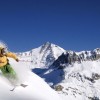

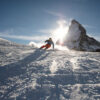





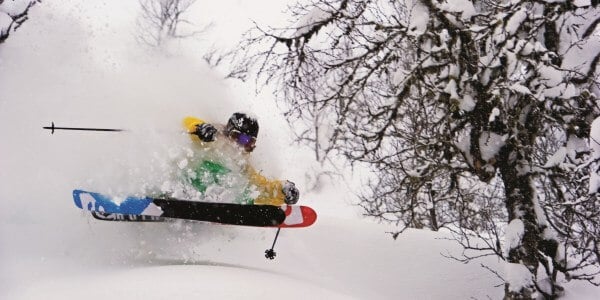

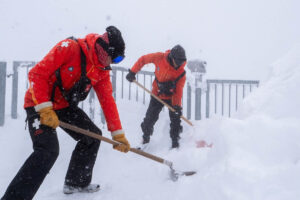
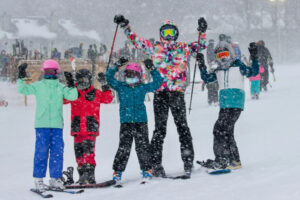
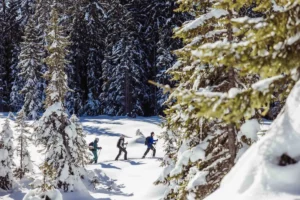
Obviously, anything which reduces the likelihood of injury is a good thing, be it wrist guards, back protectors or helmets.
But like seat belts or air bags in a car, these safety measures don’t suddenly make you invulnerable. I’m convinced that the more kit people wear the more they believe they can’t get hurt, the faster they ski and the more likely they are to have an accident.
I ski slalom in goggles and helmet. There is no-one else in the course, so I don’t need peripheral vision or hearing, and I’m going as fast as I can anyway. I’d be daft not to wear a helmet.
But skiing on-piste with about 60º of my vision missing, with reduced hearing, less spatial awareness and very little wind in my face to judge my speed by, I could become a danger to myself and to everyone else.
The solution is not necessarily to go back to my old bobble hat and shades – it is to try to remind myself constantly when wearing my helmet and goggles that I have to look around more, I have to listen more, and I have to ski at the same speed I did without them.
A helmet may have saved Schumi’s life, and thank God it did. But was he skiing a little faster and more recklessly that day because he felt safer? It has certainly happened to me…
Thanks for the great tips, considering how dangerous skiing can be in general it definitely helps to have some safety tips. In particular, I am really glad that you recommend not drinking before skiing. Not only will that make you sick when moving so fast, you also do not want to be skiing with a hangover.
Ski Safety at Down Hill areas is a responsibility of BOTH the Skiers & the Slope Resort Managers. Concentrating on only the public side of the equation does not relieve the slope management of the likely other 40%. Besides hitting the skier side with does & don’ts, where are the items the resort should upgrade for public safety? Possibly slope safety ratings like in Western US?
The National Ski Areas Association is always trying to find a phony comparison rate of death in another human activity that will make skiing DEATH accidents look good! That organization is based on making the ski accident rate look good & blame all the accidents of the skier and not the Slope Management!, when In fact, the Resort Slope Management is likely part cause of at least 40% of the slope & lift accidents.